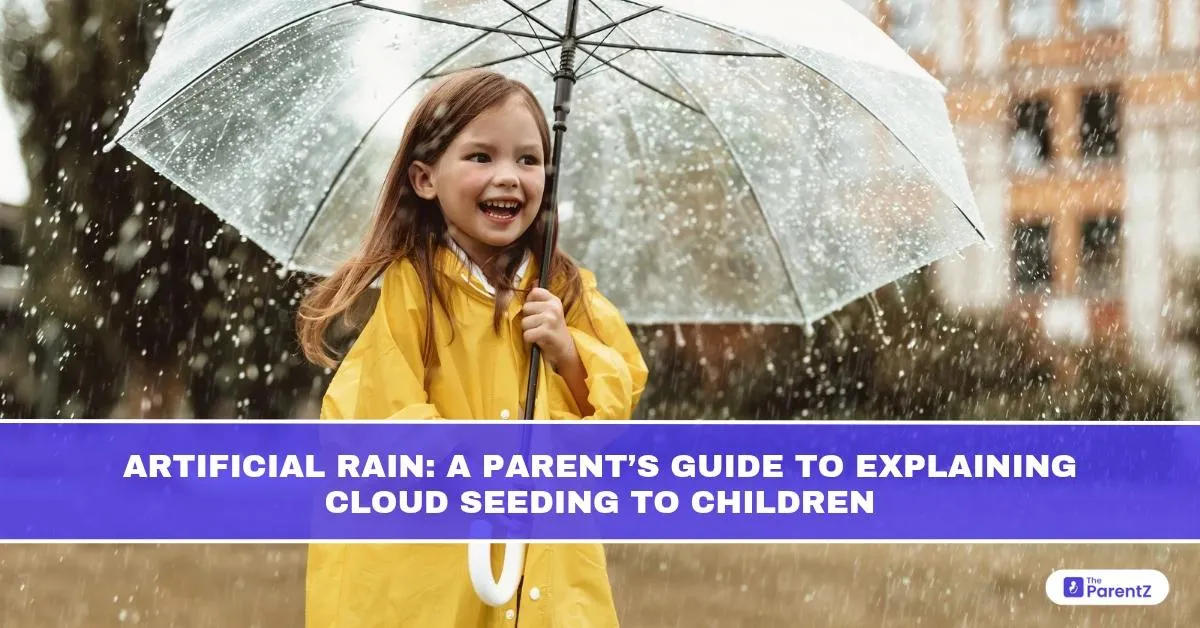Why Parents Should Teach Kids About Artificial Rain
With growing concerns over climate change, water scarcity, and unpredictable monsoons, artificial rain also called cloud seeding has become a crucial technology in many parts of the world, including India. For parents, explaining artificial rain helps children understand how humans can work with nature, appreciate the importance of water, and see how science solves real-world problems.
What Is Artificial Rain?
Artificial rain is a process where scientists help clouds release the moisture they hold. This is done by introducing certain chemicals into rain-bearing clouds to encourage water droplets to cluster together, grow larger, and eventually fall as rain. It is not a way to create new clouds; it only helps existing clouds rain more effectively.
Key Facts About Artificial Rain
- Artificial rain cannot form clouds from nothing; it requires existing clouds with enough moisture.
- The most common method to induce artificial rain is cloud seeding.
- Cloud seeding involves dispersing tiny particles, called condensation nuclei, into clouds.
- Artificial rain has been successfully used in many countries, including India, China, UAE, USA, and Australia.
- It is mainly used to increase rainfall in drought-affected regions, improve water reservoirs, or control air pollution.
A Brief History of Artificial Rain
- In 1946, Dr. Vincent Schaefer and Dr. Irving Langmuir conducted the first successful cloud seeding experiment in the USA, using dry ice to induce snowfall from supercooled clouds.
- The discovery paved the way for large-scale cloud seeding programs in the 1950s and 60s, primarily for agriculture and military purposes.
- Over time, many governments have used artificial rain to combat drought, improve water availability, or clear smog during events like the 2008 Beijing Olympics.
- In India, states like Maharashtra and Karnataka have implemented cloud seeding during critical droughts in recent decades.
How Does Artificial Rain Work?
- Meteorologists first identify clouds with adequate moisture content.
- Special aircraft, rockets, or ground-based generators are used to disperse seeding agents into the clouds.
- The seeding agents act as condensation nuclei; microscopic particles that encourage tiny water droplets in clouds to combine.
- When droplets grow large enough, they become too heavy to stay suspended and fall as rain.
- Cloud seeding cannot force clouds to produce rain if they are too dry or absent.
Components Used in Artificial Rain
- Silver iodide (AgI): The most widely used agent, chosen because its crystalline structure is similar to ice, encouraging the freezing of supercooled water droplets in clouds.
- Potassium iodide (KI): Sometimes used as an alternative to silver iodide.
- Sodium chloride (NaCl): Common table salt, used mainly in warm clouds typical of tropical regions.
- Calcium chloride (CaCl₂): Occasionally used, but less common.
- Dry ice (frozen CO₂): Used in early experiments but rarely for large-scale seeding today.
Why Is Artificial Rain Important?
- Supports Agriculture: In drought-hit regions, artificial rain can save crops, protect farmers’ livelihoods, and ensure food security.
- Improves Water Supply: It can help replenish lakes, reservoirs, and groundwater.
- Reduces Air Pollution: Rainfall can wash out particulate matter and pollutants from the atmosphere, improving air quality.
- Controls Wildfires: Artificial rain can dampen dry areas, reducing fire spread during severe forest fire seasons.
- Assists Scientific Research: Cloud seeding experiments help scientists understand weather patterns and precipitation dynamics.
Usage of Artificial Rain in India and Worldwide
In India, several states like Maharashtra, Karnataka, and Andhra Pradesh have implemented cloud seeding programs during drought years to boost rainfall. China leads globally in cloud seeding, conducting thousands of operations yearly for water security and air pollution control. Countries like the UAE, Israel, the USA, and Australia have long-standing cloud seeding programs to manage water resources in arid or drought-prone areas.
Do’s and Don’ts of Artificial Rain
Do’s
- Ensure cloud seeding is conducted by trained meteorological experts.
- Use it as part of a larger drought and water management plan.
- Monitor weather conditions carefully before planning artificial rain operations.
- Educate local communities about artificial rain to prevent misunderstandings.
Don’ts
- Don’t attempt cloud seeding without proper scientific assessment; it could lead to unexpected weather effects.
- Don’t expect it to work during completely cloudless conditions.
- Don’t rely on it as a permanent solution to water scarcity—sustainable water conservation remains essential.
- Don’t ignore possible conflicts between regions sharing clouds; artificial rain can affect neighboring areas’ rainfall patterns.
How Parents Can Explain Artificial Rain to Children
- Begin with the water cycle: explain how clouds form, fill with water, and rain naturally.
- Compare cloud seeding to adding seeds to a garden: “Just like planting seeds helps plants grow, seeding clouds helps rain happen.”
- Emphasize that artificial rain is based on science, not magic, and needs clouds already carrying water.
- Use pictures or diagrams of clouds, planes spraying seeding agents, and raindrops falling.
- Highlight why artificial rain is important for farmers, animals, and cities, especially when rain doesn’t come naturally.
- Encourage discussions on why we still need to conserve water, even when cloud seeding exists.
Final Words
Artificial rain, or cloud seeding, is a powerful scientific tool that can provide temporary relief during droughts, improve water availability, and reduce air pollution. However, it is not a substitute for sustainable water management or conservation. By teaching children about artificial rain, parents can help them appreciate science, understand the importance of water, and develop a sense of responsibility toward nature and the environment.








Be the first one to comment on this story.